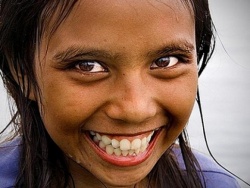Difference between revisions of "Smile"
(Created page with "thumb|250px| A smile is an expression on the face caused by happiness where the corners of the mouth turn up. Laughter is a combination of facial exp...") |
|||
| Line 1: | Line 1: | ||
[[File:Great_smile1.jpg|thumb|250px|]] | [[File:Great_smile1.jpg|thumb|250px|]] | ||
| − | A smile is an expression on the face caused by happiness where the corners of the mouth turn up. Laughter is a combination of facial expressions, sounds and bodily movements indicating strong happiness or amusement. There is no reference to the Buddha ever laughing but he is said to have had a beautiful smile and to have smiled often (S.I,24; Th.630). The Buddha’s smile, together with his calm and radiant countenance, gave him an attractiveness that naturally attracted people. His disciples were described as being ‘smiling, cheerful, exultant, joyful and with radiant complexions’ (M.II,121). The psychology of the abhidhamma recognizes several types and intensities of smiles and laughter – the gentle smile (sita), the beaming smile where the corners of the mouth turn up and the teeth can be seen (hasita), laughter that makes an audible sound (vihasita), laughter that causes the head, shoulders and arms to tremble (upahasita), laughing until tears come to the eyes (apahasita), and roaring with laughter (atihasita). | + | A [[smile]] is an expression on the face [[caused]] by [[happiness]] where the corners of the {{Wiki|mouth}} turn up. Laughter is a combination of facial expressions, {{Wiki|sounds}} and [[bodily]] movements indicating strong [[happiness]] or amusement. There is no reference to the [[Buddha]] ever laughing but he is said to have had a [[beautiful]] [[smile]] and to have smiled often (S.I,24; Th.630). The [[Buddha’s]] [[smile]], together with his [[calm]] and radiant countenance, gave him an attractiveness that naturally attracted [[people]]. His [[disciples]] were described as {{Wiki|being}} ‘smiling, cheerful, [[exultant]], [[joyful]] and with radiant complexions’ (M.II,121). The {{Wiki|psychology}} of the [[abhidhamma]] [[recognizes]] several types and intensities of [[smiles]] and laughter – the gentle [[smile]] (sita), the beaming [[smile]] where the corners of the {{Wiki|mouth}} turn up and the teeth can be seen (hasita), laughter that makes an audible [[sound]] (vihasita), laughter that [[causes]] the {{Wiki|head}}, shoulders and arms to tremble ([[upahasita]]), laughing until {{Wiki|tears}} come to the [[eyes]] ([[apahasita]]), and roaring with laughter ([[atihasita]]). |
| − | The Buddha considered loud giggling and laughing to be inappropriate for monks and nuns (A.I,260), given that their vocation is a serious one. In the Dhammapada he asks: ‘Why all this laughter and celebration when the world is on fire?’ (Dhp.146). The Mahāvastu says: ‘By living together, by a kind look and a warm smile, love is born in both human and animal.’ The Bodhicaryāvatāra advises those meditators who have a tendency to become overly serious: ‘Always have a smile on your face, give up frowning, a serious mien ... and be a friend to the whole world.’ The Buddhist peoples of Asia are renowned for their readiness to smile, a characteristic which reflects a general openness and kindness which the Buddha’s teachings impart. See Humour. | + | The [[Buddha]] considered loud giggling and laughing to be inappropriate for [[monks and nuns]] (A.I,260), given that their vocation is a serious one. In the [[Dhammapada]] he asks: ‘Why all this laughter and celebration when the [[world]] is on [[fire]]?’ (Dhp.146). The [[Mahāvastu]] says: ‘By living together, by a kind look and a warm [[smile]], [[love]] is born in both [[human]] and [[animal]].’ The [[Bodhicaryāvatāra]] advises those [[meditators]] who have a tendency to become overly serious: ‘Always have a [[smile]] on your face, give up frowning, a serious mien ... and be a friend to the whole [[world]].’ The [[Buddhist]] peoples of {{Wiki|Asia}} are renowned for their readiness to [[smile]], a [[characteristic]] which reflects a {{Wiki|general}} [[openness]] and [[kindness]] which the [[Buddha’s teachings]] impart. See [[Humour]]. |
| − | Humor in Pali Literature and Other Essays, W. Rahula,1997. | + | Humor in [[Pali Literature]] and Other Essays, W. Rahula,1997. |
{{R}} | {{R}} | ||
[http://www.buddhisma2z.com/content.php?id=386 www.buddhisma2z.com] | [http://www.buddhisma2z.com/content.php?id=386 www.buddhisma2z.com] | ||
[[Category:Buddhist Terms]] | [[Category:Buddhist Terms]] | ||
Revision as of 05:15, 24 September 2013
A smile is an expression on the face caused by happiness where the corners of the mouth turn up. Laughter is a combination of facial expressions, sounds and bodily movements indicating strong happiness or amusement. There is no reference to the Buddha ever laughing but he is said to have had a beautiful smile and to have smiled often (S.I,24; Th.630). The Buddha’s smile, together with his calm and radiant countenance, gave him an attractiveness that naturally attracted people. His disciples were described as being ‘smiling, cheerful, exultant, joyful and with radiant complexions’ (M.II,121). The psychology of the abhidhamma recognizes several types and intensities of smiles and laughter – the gentle smile (sita), the beaming smile where the corners of the mouth turn up and the teeth can be seen (hasita), laughter that makes an audible sound (vihasita), laughter that causes the head, shoulders and arms to tremble (upahasita), laughing until tears come to the eyes (apahasita), and roaring with laughter (atihasita).
The Buddha considered loud giggling and laughing to be inappropriate for monks and nuns (A.I,260), given that their vocation is a serious one. In the Dhammapada he asks: ‘Why all this laughter and celebration when the world is on fire?’ (Dhp.146). The Mahāvastu says: ‘By living together, by a kind look and a warm smile, love is born in both human and animal.’ The Bodhicaryāvatāra advises those meditators who have a tendency to become overly serious: ‘Always have a smile on your face, give up frowning, a serious mien ... and be a friend to the whole world.’ The Buddhist peoples of Asia are renowned for their readiness to smile, a characteristic which reflects a general openness and kindness which the Buddha’s teachings impart. See Humour.
Humor in Pali Literature and Other Essays, W. Rahula,1997.
